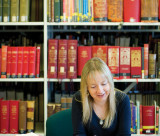
Exhibition gives a voice to the displaced
September 20th, 2012
The stories of millions of people left stranded far from home in Europe following the end of World War II are being told through an exhibition at Nottingham Castle.
When the War was Over: European Refugees After 1945 documents the experiences of those labelled Displaced Persons (DPs) by the Allied Governments, including former Nazi slave labourers, liberated prisoners-of-war, concentration camp survivors and Eastern Europeans fleeing westwards to escape the Soviet Red Army.
The exhibition has been organised by historians at The University of Nottingham and The University of Manchester and is based on a research project studying East European population displacement and resettlement after World War II.
More than 11 million people were displaced from their homes by the end of the war — roughly ten times the number after World War I.
By mid-May 1945, 10 million had been repatriated to their homeland, leaving around 1.5 million people in Displaced Persons’ camps under the administration of the United Nations and charities including the Quakers.
Conditions were poor and a lack of housing in war-ravaged Germany meant that these camps often took the form of wooden huts, disused factories or former forced labour barracks or concentration camps.
Dr Siobhan Peeling, who worked on the project at Nottingham with Dr Nick Baron in the University’s School of History, said: “The appalling human rights violations that took place across Europe during the war are well documented and remembered to this day, but people are generally less aware of the hardships endured by those who found themselves stranded away from home once peace returned to the continent.
“Many of the DPs who didn’t return home eventually went on to start a new life in other countries such as the UK and America — including the Poles and Ukrainians who came to Nottingham. However some, especially those deemed unfit to work or with a criminal conviction, languished in the camps and were only finally resettled almost 15 years later during the World Refugee Year campaign in 1959-60.”
The exhibition aims to give a voice to those refugees — and the institutions and volunteers who sought to care for them — through a rich resource of analysis, personal testimonies and original source material including photographs and film clips collected from archives and libraries in the UK, USA, Russia, the Ukraine and elsewhere.
Dr Peeling added: “The aim of the exhibition is to showcase the compelling personal stories of the migrants who were affected post-1945 and to promote thought and debate on the issue of refugees and migrants which still continues to resonate in our contemporary society.”
When the War Was Over: European Refugees After 1945 will run in the People’s Gallery space at Nottingham Castle until Sunday September 23.
The project and development of the exhibition were funded by the UK Arts and Humanities Research Council.
Leave a Reply
Other Features

Baptism of fire for WW1 curator
Stories from the First World War are being revealed for the first time at a University […]


